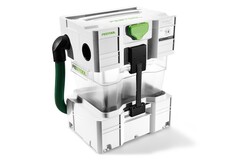Removing damaged plaster from walls

Description
One method of removing plaster is with a hammer and sickle, although this is very labour-intensive. Another is to use machines such as hammer drills and chisel hammers. However, these cannot be used with an extraction system and therefore generate large quantities of dust and dirt. This is why it is recommended that you work with a renovation miller to remove plaster and coarse fillers.
Moreover, if you wish to remove a rough structural rendering on your wall or ceiling, a renovation miller provides the opportunity to machine the plaster and then to smooth the wall and ceiling again, for example.
Tools/accessories
Alternative tools
Preparation/set-up
-
Before starting to remove the plaster, ensure that any fragile items and furniture indoors and outdoors are covered or removed to protect them from any dust generated. It is recommended that you wear protective eyewear and ear protection.

-
Since milling off plaster and fillers generates an enormous amount of dust, it is recommended that you use a pre-separator. The Festool VA collects up to 95% of the dust before it reaches the mobile dust extractor.

Procedure
-
For small surfaces
Guide the RG 80 renovation miller over the surfaces of plaster to be removed and mill at the required height.

-
For large surfaces
For large wall surfaces, it is recommended that you work with a renovation miller with a larger machine/tool head. The Renofix RG 150 has a machine/tool head with a diameter of 150 mm, making it ideal for machining plaster and filler compounds on façades.

-
For large surfaces
The HW-SZ 35 cutter wheel is ideal for removing coarse plaster and filler compounds.

-
For large surfaces
To ensure that it is easy to guide the miller across a façade, secure a balancer, for example, to the scaffolding.

-
For large surfaces
Secure the RG 150 renovation miller to the balancer. The balancer will now carry a large part of the weight.

-
For large surfaces
Connect the RG 150 renovation miller to the CTM 36 E AC HD mobile dust extractor.

-
For large surfaces
Before positioning the RG 150 on the plaster, you should specify the penetration depth of the machine/tool head. To do this, set the height required on the depth adjustment lever. The depth setting can be used at any time to determine how much material is to be removed.

-
For large surfaces
Hold the machine with both hands, press the on switch and carefully place the miller on the surface. Guide the RG 150 renovation miller over the surfaces of plaster to be removed and mill at the required height.

-
Our illustrated guides and work results are documented working steps that we have performed in practice. They are individual examples and do not guarantee or promise that users will obtain the same results. The results will depend on the user's experience and skill, as well as the material being used. Illustrated guides do not replace any Festool operating manuals and/or safety instructions. Liability for ensuring that the information, instructions and applications are free from content defects and defects of title, in particular with regard to the absence of defects, correctness, freedom from third party intellectual property rights and copyrights, completeness and fitness for purpose, is excluded. Claims for damages made by the user, regardless of their legal basis, are excluded. These liability exclusions are not applicable if the damage was intentional or caused by gross negligence, or in cases of statutory liability.
We cannot accept liability for damage resulting from defects.↑




